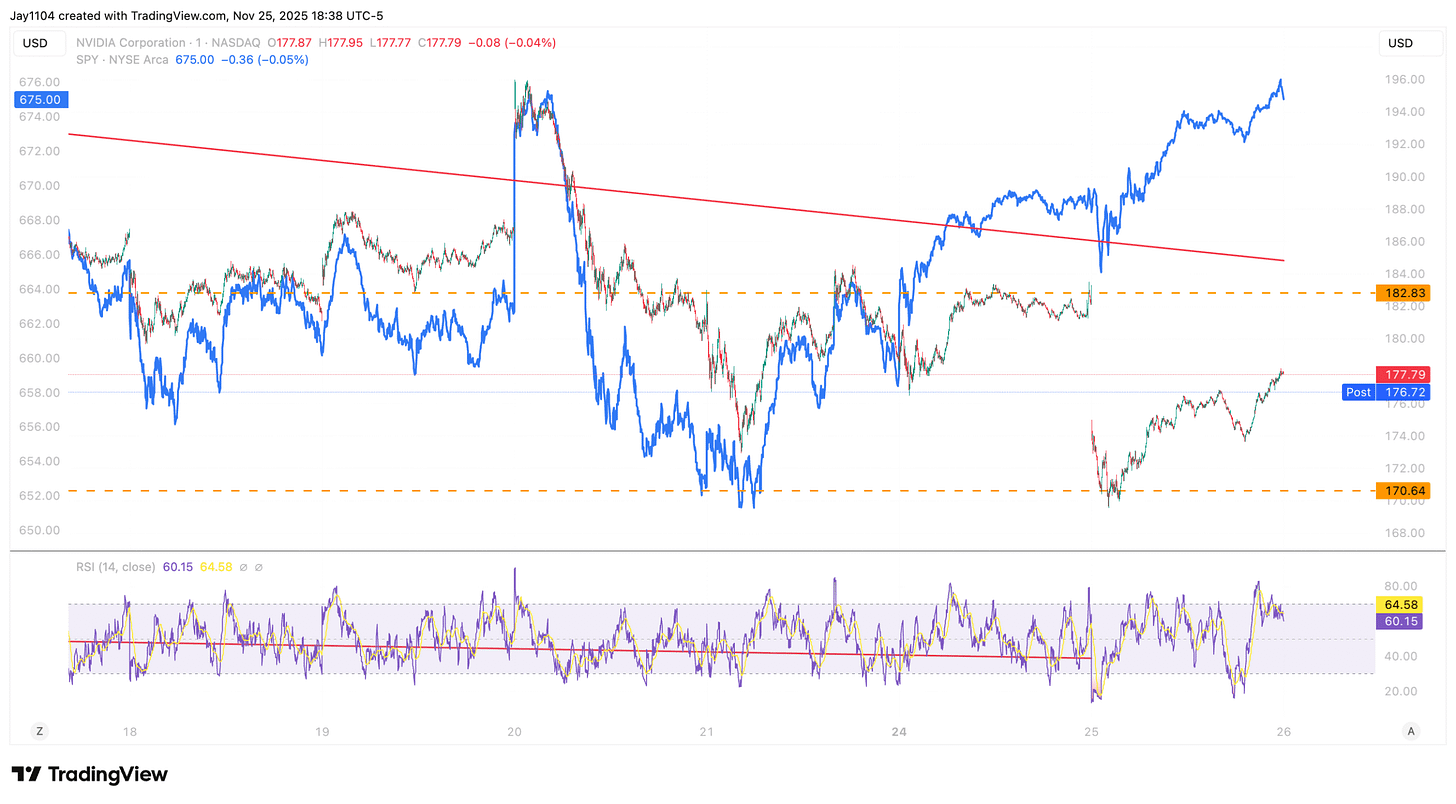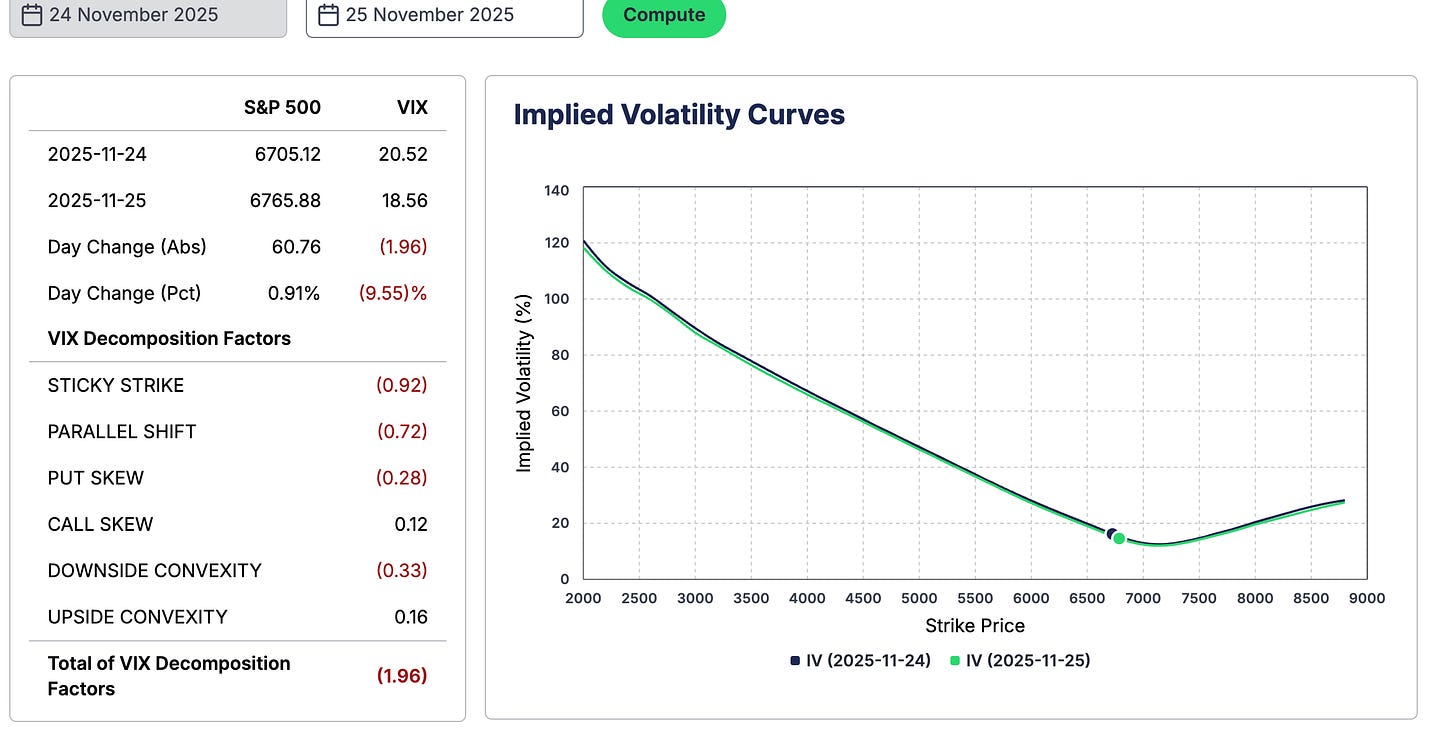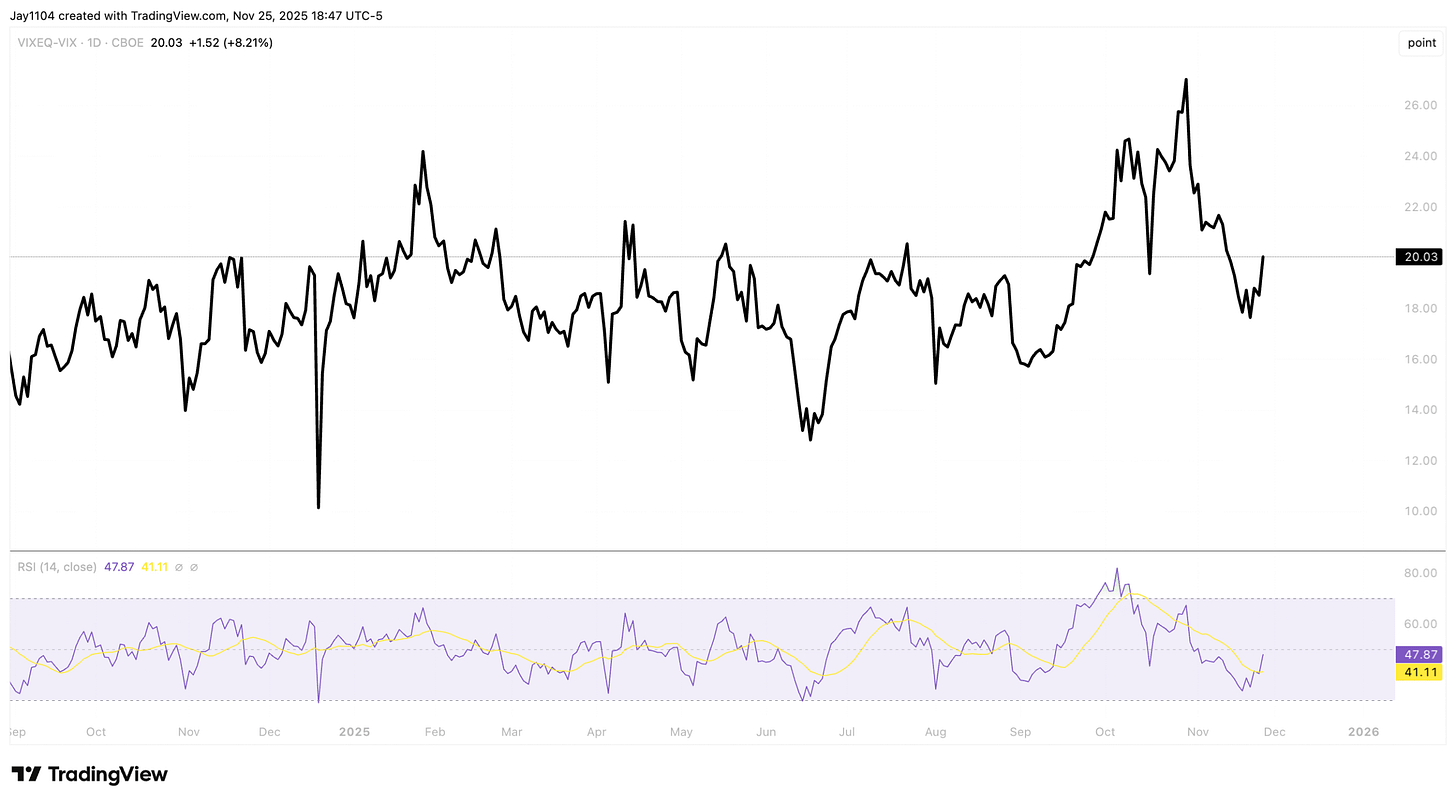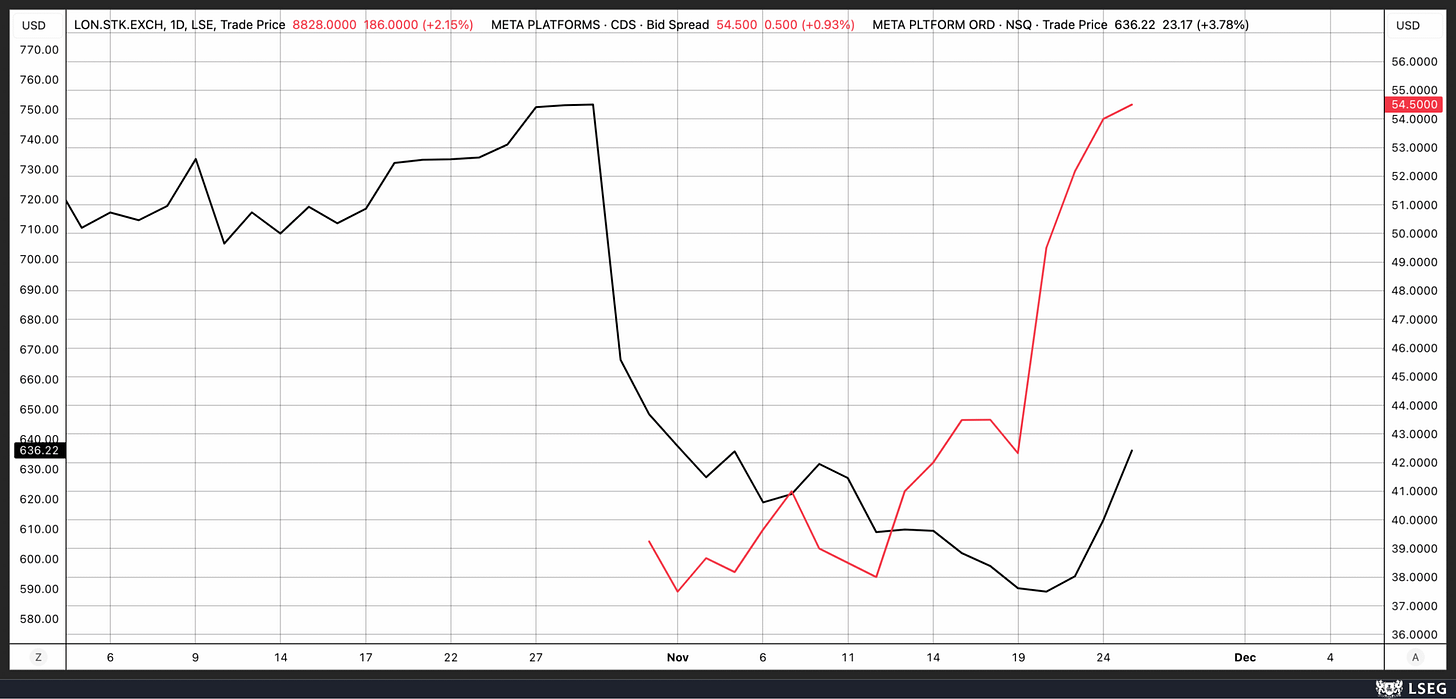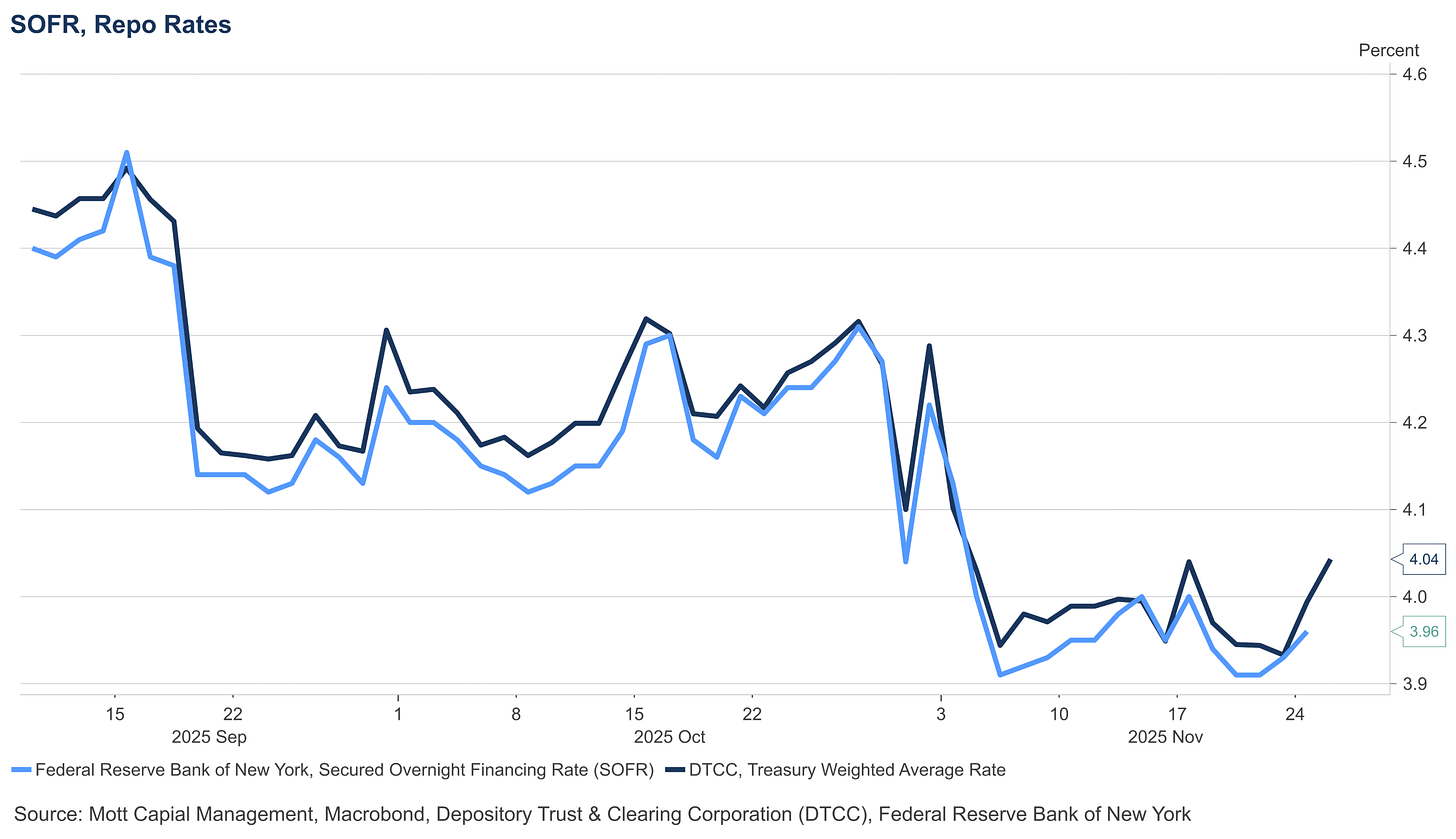Volatility Dispersion Forces Override Liquidity Headwinds
Take advantage of a 20% discount on all Navigating The Market subscription options now through December 3.
Stocks were surprisingly higher on November 25th, even though it was a Treasury settlement day and we saw overnight funding rates rise, notable usage of the Standing Repo Facility increased, and a drop in Bitcoin. Given those conditions, it would have made sense for the S&P 500 to finish lower overall. In fact, the index fell sharply at the open—by nearly 80 basis points at one point—before reversing and grinding higher for the rest of the session as implied volatility was sold, potentially due to the shortened trading week.
It’s not unusual to see implied volatility sold ahead of holiday trading sessions, since time decay remains the same while the number of trading days decreases, making it an attractive setup for shorting volatility. That appears to be what happened on November 25th, despite what otherwise seemed like favorable conditions for the market to trade lower.
Adding insult to injury, NVIDIA was down more than 2% on the day and had traded as low as 6% at one point in the morning. But it didn’t matter, because the other 493 stocks were pushed higher, and Meta helped lift the index as well. So, at least for the moment, it seemed there was a mechanical force in the market that was able to override tight liquidity conditions, higher overnight funding rates, and even an underperforming NASDAQ 100 throughout the session.
In fact, the CBOE VIX decomposition tool clearly shows what drove the VIX drop from November 24 to November 25. Almost the entire decline came from mechanical volatility factors—not fundamentals, not macro dynamics, and not a sudden reduction in downside risk. The biggest contributors were Sticky Strike at –0.92 and Parallel Shift at –0.72, which together accounted for the majority of the total move. These factors essentially reflect market makers marking down volatility across the curve and adjusting IV levels most likely to account for the shortened trading week.
In essence, today was nothing more than a volatility dispersion day. The constituent volatility index fell less than the VIX, while the dispersion index moved higher. This is exactly the type of behavior we typically see on volatility-dispersion days, likely driven by the holiday and the shortened trading week.
Another interesting fact was that Meta’s gain of nearly 4% was accompanied by the CDS widening on the day.
SOFR is likely to be higher tomorrow. The overnight repo rate at the DTCC rose to 4.04% today, up from 3.97% on November 24, and that typically leads to SOFR rising. Given today’s move, tomorrow’s SOFR is likely to be higher than today’s 3.96% level, probably over 4%. The real liquidity pressures are most likely to come on Friday and Monday, when almost $130 billion in Treasuries are due to settle.
Finally, SoftBank fell another 10% yesterday and has now retraced all the gains it had made since the beginning of September, suggesting that the gamma squeeze that previously supported the stock is now over. If the shares break 14,000 yen, the next support level lies at 12,000.
-Mike
Glossary by ChatGPT
Basis Points (bps): A unit equal to one-hundredth of a percentage point used to measure changes in interest rates or financial metrics.
CDS (Credit Default Swap): A derivative contract that provides protection against the default of a borrower.
CBOE VIX Decomposition Tool: A model that breaks down the drivers of changes in the VIX into mechanical and market-driven components.
Dispersion Index: A measure tracking differences between index volatility and the volatility of its individual components.
Gamma Squeeze: A rapid price increase driven by dealers hedging short-dated options exposure, forcing additional buying as prices rise.
Implied Volatility (IV): The market’s expectation of future price fluctuations embedded in options prices.
Parallel Shift: A uniform move in implied volatility levels across all option strikes or maturities.
SOFR (Secured Overnight Financing Rate): A benchmark interest rate reflecting the cost of overnight borrowing collateralized by U.S. Treasuries.
Standing Repo Facility: A Federal Reserve tool that lends cash overnight against Treasury collateral at a fixed rate.
Sticky Strike: A volatility behavior in which implied volatility is adjusted at specific strikes despite broader market movements.
Treasury Settlement Day: The date on which buyers of U.S. Treasury securities must pay for and receive the securities they purchased.
Disclosure
This report contains independent commentary to be used for informational and educational purposes only. Michael Kramer is a member and investment adviser representative with Mott Capital Management. Mr. Kramer is not affiliated with this company and does not serve on the board of any related company that issued this stock. All opinions and analyses presented by Michael Kramer in this analysis or market report are solely Michael Kramer’s views. Readers should not treat any opinion, viewpoint, or prediction expressed by Michael Kramer as a specific solicitation or recommendation to buy or sell a particular security or follow a particular strategy. Michael Kramer’s analyses are based upon information and independent research that he considers reliable, but neither Michael Kramer nor Mott Capital Management guarantees its completeness or accuracy, and it should not be relied upon as such. Michael Kramer is not under any obligation to update or correct any information presented in his analyses. Mr. Kramer’s statements, guidance, and opinions are subject to change without notice. Past performance is not indicative of future results. Neither Michael Kramer nor Mott Capital Management guarantees any specific outcome or profit. You should be aware of the real risk of loss in following any strategy or investment commentary presented in this analysis. Strategies or investments discussed may fluctuate in price or value. Investments or strategies mentioned in this analysis may not be suitable for you. This material does not consider your particular investment objectives, financial situation, or needs and is not intended as a recommendation appropriate for you. You must make an independent decision regarding investments or strategies in this analysis. Upon request, the advisor will provide a list of all recommendations made during the past twelve months. Before acting on information in this analysis, you should consider whether it is suitable for your circumstances and strongly consider seeking advice from your own financial or investment adviser to determine the suitability of any investment.



